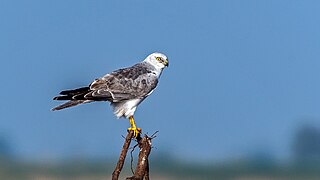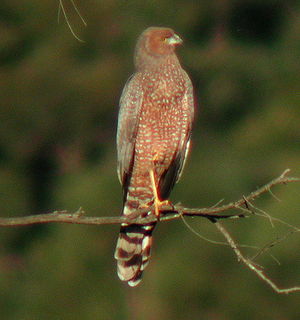 W
WA harrier is any of the several species of diurnal hawks sometimes placed in the subfamily Circinae of the bird of prey family Accipitridae. Harriers characteristically hunt by flying low over open ground, feeding on small mammals, reptiles, or birds. The young of the species are sometimes referred to as ring-tail harriers. They are distinctive with long wings, a long narrow tail, the slow and low flight over grasslands and skull peculiarities. The harriers are thought to have diversified with the expansion of grasslands and the emergence of C4 grasses about 6 to 8 million years ago during the Late Miocene and Pliocene.
 W
WThe African marsh harrier is a bird of prey belonging to the harrier genus Circus. It is largely resident in wetland habitats in southern, central and eastern Africa from South Africa north to South Sudan.
 W
WThe black harrier is a medium-sized African harrier whose range extends from South Africa to Botswana and Namibia. It has a wingspan of 105–115 cm (41–45 in) and a body length of 44–50 cm (17–20 in). When perched, this bird appears all black. However, in flight a white rump and flight feathers become visible. Its morphology is comparable to that of other harriers, with a slim body, narrow wings and a long tail. Male and female plumages are similar. Juveniles have buff under-parts and heavily spotted breasts.
 W
WThe cinereous harrier is a South American bird of prey of the harrier family. Its breeding range extends from the Tierra del Fuego through Argentina and Chile to Bolivia, Paraguay, Peru and southern Brasil; and across the Andes north to Colombia. The bird's population is declining but due to its large range is not considered vulnerable. The term cinereous, deriving from the Latin word for ashy, describes its colouration.
 W
WThe eastern marsh harrier is a bird of prey belonging to the marsh harrier group of harriers. It was previously considered to be conspecific with the western marsh harrier but is now usually classified as a separate species. It has two subspecies: C. s. spilonotus in eastern Asia and C. s. spilothorax in New Guinea.
 W
WThe hen harrier is a bird of prey. The genus name Circus is derived from Ancient Greek kirkos 'circle', referring to a bird of prey named for its circling flight. The specific cyaneus is Latin, meaning "dark-blue".
 W
WThe long-winged harrier is a common bird of prey species endemic to South America. They are members of the family Accipitridae, under the genus Circus which encompasses other harrier species. Its range encompasses most of South America, in grassland and wetland all across the continent. The long-winged harrier is a carnivorous bird, and will feed on many different animals found in its habitat.
 W
WThe Malagasy harrier is a bird of prey belonging to the marsh harrier group of harriers. It inhabits Madagascar and the Comoro Islands in the Indian Ocean. It was formerly regarded as a subspecies of the Réunion harrier but is increasingly treated as a separate species. It is also known as the Madagascar harrier, Madagascar marsh harrier or Malagasy marsh harrier.
 W
WThe marsh harriers are birds of prey of the harrier subfamily. They are medium-sized raptors and the largest and broadest-winged harriers. Most of them are associated with marshland and dense reedbeds. They are found almost worldwide, excluding only the Americas.
 W
WMontagu's harrier (Circus pygargus) is a migratory bird of prey of the harrier family. Its common name commemorates the British naturalist George Montagu.
 W
WThe northern harrier is a bird of prey.
 W
WThe pale or pallid harrier is a migratory bird of prey of the harrier family. The scientific name is derived from the Ancient Greek. Circus is from kirkos, referring to a bird of prey named for its circling flight, probably the hen harrier and macrourus is "long-tailed", from makros, "long" and -ouros "-tailed".
 W
WThe pied harrier is an Asian species of bird of prey in the family Accipitridae. It is migratory, breeding from the Amur valley in eastern Russia and north-eastern China to North Korea. Wintering individuals can be found in a wide area from Pakistan to Philippines. The population consists of approximately 10,000 individuals and the number is thought to be in moderate decline.
 W
WThe Réunion harrier or Réunion marsh harrier is a bird of prey belonging to the marsh harrier group of harriers. It is now found only on the Indian Ocean island of Réunion, although fossil material from Mauritius has been referred to this species. It is known locally as the papangue or pied jaune. The Malagasy harrier of Madagascar and the Comoro Islands was previously treated as a subspecies of this bird but is increasingly regarded as a separate species. The Réunion harrier appears to be declining in numbers and it is classed as an endangered species.
 W
WThe spotted harrier also known as the smoke hawk, is a large Australasian bird of prey belonging to the family Accipitridae.
 W
WThe swamp harrier - also known as the Australasian marsh harrier, Australasian harrier, or swamp-hawk - is a large, slim bird of prey widely distributed across Australasia. In New Zealand it is also known as the harrier hawk, or by the Māori name kāhu. Its arrival in New Zealand happened recently within the last 700 years, replacing its extinct larger New Zealand endemic sister species Eyles's harrier.
 W
WThe western marsh harrier is a large harrier, a bird of prey from temperate and subtropical western Eurasia and adjacent Africa. It is also known as the Eurasian marsh harrier. The genus name Circus is derived from the Ancient Greek kirkos, referring to a bird of prey named for its circling flight, probably the hen harrier. The specific aeruginosus is Latin for "rusty".